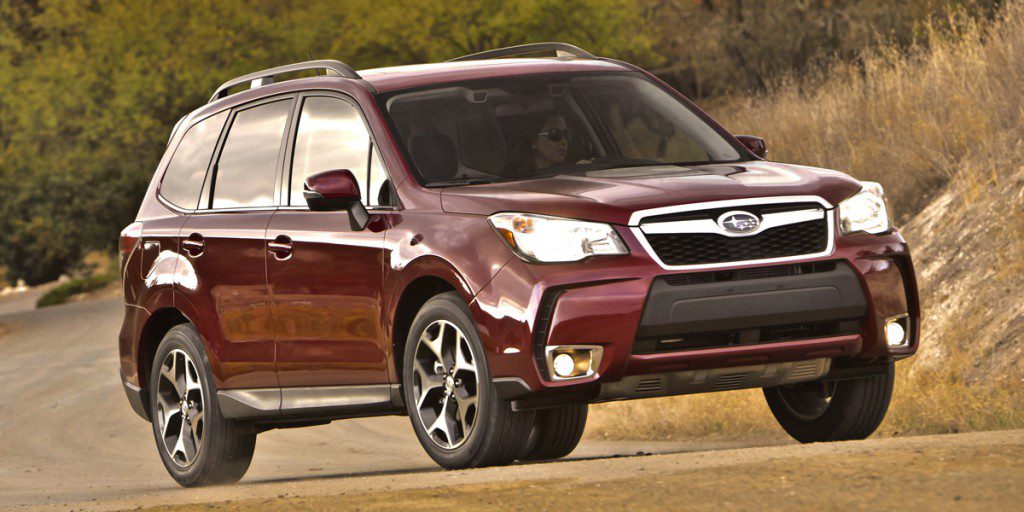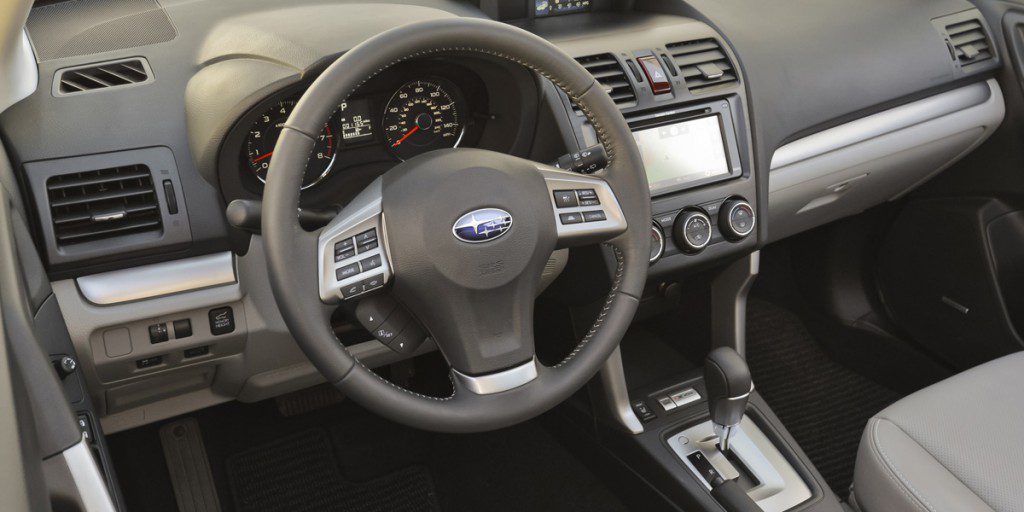| Compact SUV; Built in |
|
|
| Good condition price range: $16,100 – $30,100* |

2014 Subaru Forester

2014 Subaru Forester

2014 Subaru Forester

2014 Subaru Forester
| Pros: |
|
| Cons: |
|
Forester remains competitive by adding passenger and cargo room, and bringing in features like hill-descent control and the optional EyeSight system with pre-collision braking and lane-departure warning. Performance of the 2.5-liter engine with the CVT doesn’t peg the thrill meter, but models equipped with it offer the best value. Turbocharged XTs have more pleasing performance, but cost more to buy and feed with no gain in utility.
Overview
Forester was Subaru’s all-wheel-drive compact sport-utility vehicle. The redesigned fourth generation of the Forester arrived for 2014 with new styling, slightly larger dimensions, new powertrains, and a number of first-time features.
Wheelbase was stretched 0.9 inch (to 103.9), which, with specially shaped front seat backs, contributed to added legroom for rear-seat passengers. They also benefited from a lower driveline tunnel and additional hip and shoulder room. The 2014 Forester was 1.4 inches longer overall and 0.6 inch wider than its predecessor. Cargo space was also increased, by as much as 9 percent.
A 2.5-liter horizontally opposed 4-cylinder engine continued to be available, but a 2.0-liter turbocharged 4-cylinder “boxer” engine replaced the 2.5-liter turbo engine used previously. They were paired with all-new transmissions: a 6-speed manual, a continuously variable transmission (CVT) that behaved like an automatic, or–for turbo models–a high-torque CVT with steering-wheel paddles that allowed for driver-selected shifts.
The top two 2.5-liter models and all turbocharged Foresters incorporated the new X-Mode system, which provided extra control in certain low-traction situations and included a hill-descent control feature. A rearview camera became standard for all but base models, and an in-dash navigation system was made more widely available. Turbo models incorporated SI-DRIVE (for “Subaru Intelligent Drive”), a multimode system that changed throttle response for faster acceleration.
Subaru offered the Forester in 2.5i, 2.5i Premium, 2.5i Limited, 2.5i Touring, 2.0XT Premium, and 2.0XT Touring versions.
The base 2.5i came standard with all-wheel-drive, 17-inch steel wheels (an inch bigger than on the prior model), 6-speed manual transmission, split-folding rear seat backs, cruise control, air conditioning, power windows/locks/mirrors, and Bluetooth connectivity. A tilt-and-telescopic steering column and in-dash fuel-economy and exterior-temperature display were new base-model standard features.
The 2.5i Premium added alloy wheels, 10-way power driver seat, HD Radio receiver, rearview camera, body-color mirrors, and roof rails. A color multifunction display monitored additional vehicle systems and served as the rearview camera screen. Premiums with manual transmission received the All-Weather Package with heated front seats, heated exterior mirrors, and windshield wiper de-icer; those with the optional CVT came with a panoramic sunroof.
The 2.5i Limited added the CVT, X-Mode with hill-descent control, automatic climate control, leather upholstery, leather-wrapped steering wheel and shifter handle, upgraded instrument cluster, automatic headlights, fog lights, and a cargo area tray. All Limiteds also included the All-Weather Package.
The 2.5i Touring added dual-zone automatic climate control, a one-touch folding rear seatback, and turn signals integrated into the exterior mirrors. New Touring-level standard equipment included an in-dash navigation system with a 6.1-inch touchscreen, electroluminescent instrumentation, 8-speaker Harman/Kardon audio system, and a power liftgate that could be programmed to raise to a specified height.
The 2.0XT Premium received a turbocharged 4-cylinder engine, high-torque CVT with SI-DRIVE (including paddle shifters), X-Mode, a sport suspension with 18-inch wheels and uprated brakes, and leather-wrapped steering wheel and shifter handle. The 2.0XT Touring received the same amenities included on the 2.5i Touring. Frontal styling of turbo Foresters differed slightly from that used on 2.5i models. XTs also sported a body-color rear roof spoiler and dual stainless-steel exhaust tips.
The CVT was available at extra cost for the base 2.5i and 2.5i Premium, and the All-Weather Package was optional on Premiums equipped with the CVT. The in-dash navigation system was optional for 2.5i Premium and 2.0XT Premium models and the 2.5i Limited. It came with an upgraded 6-speaker audio system and smartphone integration with the Aha platform that created access to Internet-based information and entertainment services.
Both Touring-level models could be equipped with a driver-assist technology package. Aside from keyless access and starting and high-intensity discharge headlights, the package extended Subaru’s EyeSight system to the Forester. EyeSight provided adaptive cruise control, pre-collision braking and throttle management, and lane-departure warning.
Forester 2.5i models had a 170-horsepower 2.5-liter 4-cylinder engine that used Subaru’s traditional horizontally opposed “boxer” design. The 2.5i and 2.5i Premium models came standard with a 6-speed manual transmission. A CVT that behaved like an automatic was optional on those Foresters and standard on the 2.5i Limited and 2.5i Touring.
Forester 2.0XT models were equipped with a 250-horsepower turbocharged 2.0-liter 4-cylinder engine. It also used Subaru’s traditional boxer design. The only transmission available on turbocharged Foresters was a CVT.
All Foresters were all-wheel drive.
The EPA estimated that the 2014 Forester 2.5i with the 6-speed manual transmission would return 22 mpg city and 29 mpg highway. For 2.5i models with the CVT, official estimates were 24 mpg city and 32 mpg highway. Estimates for the turbocharged 2.0XT were 23 mpg city and 28 mpg highway.
All Forester 2.5i models used regular-grade gas. Subaru recommended premium for turbocharged 2.0XTs.
Foresters came standard with all expected safety features. New for 2014 were anti-whiplash front seats, a driver’s-knee airbag, brake override that cuts engine power if the driver simultaneously applied the brake and accelerator past a certain threshold, and impact-sensing fuel cutoff that activated in an airbag-deployment crash.
Yearly Updates
| 2014 Forester |
